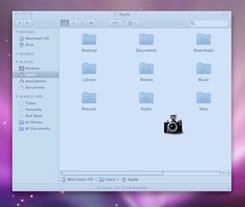Screen Capture in Mac OS X
 I use screenshots constantly to share bits of information with people, and they can be really helpful when troubleshooting as well.
I use screenshots constantly to share bits of information with people, and they can be really helpful when troubleshooting as well.
Here’s all you’ll need to know about taking screenshots in Mac OS X, from capturing the screen in Mac OS X Finder and within applications, to changing the default screenshot file type, to taking screenshots from the command line.
Capturing screenshots in Mac OS X
You can use any of these commands to take screenshots directly in Mac OS X Finder or any running applications:
- Command+Shift+3: takes a screenshot of the full screen (or screens if multiple monitors), and save it as a file to the desktop
- Command+Shift+4: brings up a selection box so you can specify an area to take a screenshot of, then save it as a file to the desktop
- Command+Shift+4, then spacebar, then click a window: takes a screenshot of a window only and saves it as a file to the desktop
- Command+Control+Shift+3: take a screenshot of the entire screen (screens if multiple monitors), and saves it to the clipboard for pasting elsewhere
- Command+Control+Shift+4, then select an area: takes a screenshot of selection and saves it to the clipboard for pasting elsewhere
- Command+Control+Shift+4, then space, then click a window: takes a screenshot of a window and saves it to the clipboard for pasting
Some of the above instructions are borrowed from our print screen on a Mac article.
Change the screen capture file format
You can change the default file type for screen captures by using a terminal command. Most major image formats are supported including PNG, PDF, GIF, TIFF, and JPG, we’ll go with JPG since that is a common type of web graphic:
defaults write com.apple.screencapture type jpg
Then you must kill the SystemUIServer for changes to take effect:
killall SystemUIServer
Take a screenshot from the command line
You can take screenshots from the command line by using the screencapture utility:
screencapture test.jpg The screen capture will then appear in the directory that the command was executed.
If you want to open the screencapture in Preview immediately after being taken, type:
screencapture -P test.jpg
You can also take screenshots silently, without the sound playing with -x:
screencapture -x silentscreenshot.jpg
If you would like to have a delay added to when the screenshot is taken use -T followed by a number of seconds:
screencapture -T 3 delayedpic.jpg
Specifying a file type is easy with the -t flag:
screencapture -t pdf pdfshot.pdf
Naturally you can combine them all together:
screencapture -xt pdf -T 4 pic.jpg
You can get a full list of screencapture flags by typing:
screencapture -h


Hey, you just saved my life with this article, googled forever and kept getting wrong results, now i can screen grab to PDF and didn’t know about the 4 option as i always used number 3. My client can’t see when i email jpeg to his blackberry and saving a low scale pdf every time i do a change is zoo time consuming… now i can do it all with a simple cmd, shift and 4.. .your a star …. thanks
[…] from the keyboard shortcuts, Grab, and other screen shot apps, you can also take screenshots of your Mac OS X desktop directly […]
Regarding the file type for screen captures… another easier way to change the file type is to install the Secrets system preferences panel. It has a simple drop down menu that makes setting that preference a click away. Here’s a screen shot of how it looks:
http://db.tt/B2HdSHU
[…] take a screen capture of an individual window using Command+Shift+4 and the screen shot will not include the window […]
[…] You can adjust the time to anything in seconds, that example is for a 10 second delay. The filename follows, which will be created in your users home directory unless you specify otherwise. You can see some more screencapture options here. […]
Thanks so much for the post! It was just what I was looking for.
[…] OS X, Tips & Tricks – January 26th, 2011 – No Comments By default, anytime you take a screen capture in Mac OS X it will save the screenshot file to the current users desktop. You can adjust where Mac OS X saves […]
[…] a screen selection and upload to Facebook – much like your standard Mac screen capture function plus […]
[…] if you take a screen capture, it’ll appear as whatever file type you […]
[…] instructions appeared on our screen capture in Mac OS […]
Thanks for the post. And did u know anything about Actymac ScreenShots Remote? Did u read any reviews of this program? I know that it allows to get screenshotrs of Mac with iPhone or iPad.
I would also add the free utility Skitch which has the added benefit of being able to add text and graphics (lines, circles, boxes, arrows).
http://skitch.com